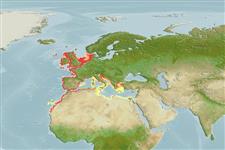Environment: milieu / climate zone / depth range / distribution range
Ecología
marino demersal; rango de profundidad 3 - 50 m (Ref. 130224). Subtropical; 59°N - 20°N, 19°W - 36°E
Eastern Atlantic: North Sea to the Mediterranean, Morocco and Madeira. Reported from the Canary Islands (Ref. 3397).
Tamaño / Peso / Age
Maturity: Lm ? range ? - ? cm
Max length : 27.7 cm TL macho / no sexado; (Ref. 128593); common length : 10.0 cm TL macho / no sexado; (Ref. 4645); peso máximo publicado: 166.17 g (Ref. 128593)
Body elongate. Coloration grey-brown on the back and silvery-white on the sides. No spines in front of the eyes (Ref. 35388).
Littoral and benthic, on sandy, muddy or gravelly bottoms, from a few meters to about 150 m (in winter). Rest on the bottom, often buried with eyes and tip of first dorsal fin exposed. Considered as the most dangerous of the European weevers, both for its poison and for its frequent occurrence very near to beaches (Ref. 4675). There are venom glands on the first dorsal fin, which is totally black, and on the gill cover (Ref. 6790). Also Ref. 57406.
Life cycle and mating behavior
Madurez | Reproducción | Puesta | Huevos | Fecundidad | Larva
Roux, C., 1990. Trachinidae. p. 893-895. In J.C. Quero, J.C. Hureau, C. Karrer, A. Post and L. Saldanha (eds.) Check-list of the fishes of the eastern tropical Atlantic (CLOFETA). JNICT, Lisbon; SEI, Paris; and UNESCO, Paris. Vol. 2. (Ref. 6790)
IUCN Red List Status (Ref. 130435: Version 2024-1)
Human uses
Pesquerías: escaso valor comercial; pesca deportiva: si
Herramientas
Special reports
Download XML
Fuentes de Internet
Estimates based on models
Preferred temperature (Ref.
123201): 7.3 - 16.1, mean 10.5 °C (based on 734 cells).
Phylogenetic diversity index (Ref.
82804): PD
50 = 1.0020 [Uniqueness, from 0.5 = low to 2.0 = high].
Bayesian length-weight: a=0.00692 (0.00444 - 0.01078), b=3.06 (2.93 - 3.19), in cm total length, based on LWR estimates for this species & (Sub)family-body (Ref.
93245).
Nivel trófico (Ref.
69278): 4.4 ±0.7 se; based on diet studies.
Resiliencia (Ref.
120179): Medio, población duplicada en un tiempo mínimo de 1.4-4.4 años (Preliminary K or Fecundity.).
Fishing Vulnerability (Ref.
59153): Low vulnerability (18 of 100).
Nutrients (Ref.
124155): Calcium = 147 [78, 319] mg/100g; Iron = 1.21 [0.72, 2.22] mg/100g; Protein = 18.5 [17.5, 19.4] %; Omega3 = 0.306 [0.172, 0.539] g/100g; Selenium = 22 [10, 49] μg/100g; VitaminA = 42.1 [14.1, 137.5] μg/100g; Zinc = 0.819 [0.532, 1.216] mg/100g (wet weight); based on
nutrient studies.
